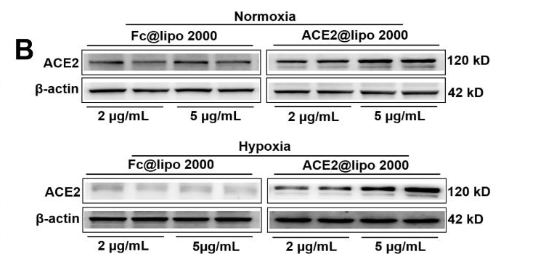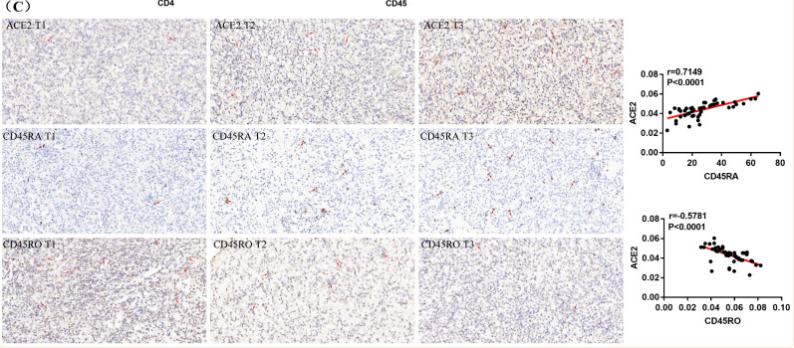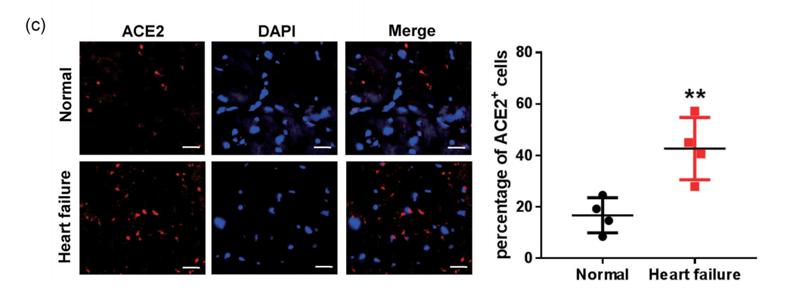ACE2 Antibody - #AF5165
| Product: | ACE2 Antibody |
| Catalog: | AF5165 |
| Description: | Rabbit polyclonal antibody to ACE2 |
| Application: | WB IHC IF/ICC |
| Reactivity: | Human, Mouse, Rat |
| Prediction: | Pig, Bovine, Horse, Sheep, Rabbit, Dog |
| Mol.Wt.: | 92 kDa, 100-120kD(Glycosylated); 92kD(Calculated). |
| Uniprot: | Q9BYF1 |
| RRID: | AB_2837651 |
Related Downloads
Protocols
Product Info
*The optimal dilutions should be determined by the end user.
*Tips:
WB: For western blot detection of denatured protein samples. IHC: For immunohistochemical detection of paraffin sections (IHC-p) or frozen sections (IHC-f) of tissue samples. IF/ICC: For immunofluorescence detection of cell samples. ELISA(peptide): For ELISA detection of antigenic peptide.
Cite Format: Affinity Biosciences Cat# AF5165, RRID:AB_2837651.
Fold/Unfold
ACE 2; ACE related carboxypeptidase; ACE-related carboxypeptidase; ACE2; ACE2_HUMAN; ACEH; Angiotensin converting enzyme 2; Angiotensin converting enzyme homolog; Angiotensin converting enzyme like protein; Angiotensin I Converting Enzyme (peptidyl dipeptidase A) 2; Angiotensin I converting enzyme 2; Angiotensin-converting enzyme homolog; DKFZP434A014; EC 3.4.17; metalloprotease MPROT 15; Metalloprotease MPROT15; OTTHUMP00000022963; Processed angiotensin-converting enzyme 2;
Immunogens
Expressed in endothelial cells from small and large arteries, and in arterial smooth muscle cells (at protein level) (PubMed:15141377). Expressed in lung alveolar epithelial cells, enterocytes of the small intestine, Leydig cells and Sertoli cells (at protein level) (PubMed:15141377). Expressed in the renal proximal tubule and the small intestine (at protein level) (PubMed:18424768). Expressed in heart, kidney, testis, and gastrointestinal system (PubMed:10969042, PubMed:10924499, PubMed:15231706, PubMed:12459472, PubMed:15671045).
- Q9BYF1 ACE2_HUMAN:
- Protein BLAST With
- NCBI/
- ExPASy/
- Uniprot
MSSSSWLLLSLVAVTAAQSTIEEQAKTFLDKFNHEAEDLFYQSSLASWNYNTNITEENVQNMNNAGDKWSAFLKEQSTLAQMYPLQEIQNLTVKLQLQALQQNGSSVLSEDKSKRLNTILNTMSTIYSTGKVCNPDNPQECLLLEPGLNEIMANSLDYNERLWAWESWRSEVGKQLRPLYEEYVVLKNEMARANHYEDYGDYWRGDYEVNGVDGYDYSRGQLIEDVEHTFEEIKPLYEHLHAYVRAKLMNAYPSYISPIGCLPAHLLGDMWGRFWTNLYSLTVPFGQKPNIDVTDAMVDQAWDAQRIFKEAEKFFVSVGLPNMTQGFWENSMLTDPGNVQKAVCHPTAWDLGKGDFRILMCTKVTMDDFLTAHHEMGHIQYDMAYAAQPFLLRNGANEGFHEAVGEIMSLSAATPKHLKSIGLLSPDFQEDNETEINFLLKQALTIVGTLPFTYMLEKWRWMVFKGEIPKDQWMKKWWEMKREIVGVVEPVPHDETYCDPASLFHVSNDYSFIRYYTRTLYQFQFQEALCQAAKHEGPLHKCDISNSTEAGQKLFNMLRLGKSEPWTLALENVVGAKNMNVRPLLNYFEPLFTWLKDQNKNSFVGWSTDWSPYADQSIKVRISLKSALGDKAYEWNDNEMYLFRSSVAYAMRQYFLKVKNQMILFGEEDVRVANLKPRISFNFFVTAPKNVSDIIPRTEVEKAIRMSRSRINDAFRLNDNSLEFLGIQPTLGPPNQPPVSIWLIVFGVVMGVIVVGIVILIFTGIRDRKKKNKARSGENPYASIDISKGENNPGFQNTDDVQTSF
Predictions
Score>80(red) has high confidence and is suggested to be used for WB detection. *The prediction model is mainly based on the alignment of immunogen sequences, the results are for reference only, not as the basis of quality assurance.
High(score>80) Medium(80>score>50) Low(score<50) No confidence
PTMs - Q9BYF1 As Substrate
| Site | PTM Type | Enzyme | Source |
|---|---|---|---|
| S2 | Phosphorylation | Uniprot | |
| S10 | Phosphorylation | Uniprot | |
| N53 | N-Glycosylation | Uniprot | |
| N90 | N-Glycosylation | Uniprot | |
| N103 | N-Glycosylation | Uniprot | |
| S128 | Phosphorylation | Uniprot | |
| T129 | Phosphorylation | Uniprot | |
| N322 | N-Glycosylation | Uniprot | |
| N432 | N-Glycosylation | Uniprot | |
| S545 | Phosphorylation | Uniprot | |
| N546 | N-Glycosylation | Uniprot | |
| S547 | Phosphorylation | Uniprot | |
| T548 | Phosphorylation | Uniprot | |
| K625 | Ubiquitination | Uniprot | |
| K676 | Ubiquitination | Uniprot | |
| S692 | Phosphorylation | Uniprot | |
| K770 | Acetylation | Uniprot | |
| K771 | Acetylation | Uniprot | |
| K773 | Acetylation | Uniprot | |
| Y781 | Phosphorylation | Uniprot | |
| S783 | Phosphorylation | Uniprot |
Research Backgrounds
Carboxypeptidase which converts angiotensin I to angiotensin 1-9, a peptide of unknown function, and angiotensin II to angiotensin 1-7, a vasodilator. Also able to hydrolyze apelin-13 and dynorphin-13 with high efficiency. By cleavage of angiotensin II, may be an important regulator of heart function. By cleavage of angiotensin II, may also have a protective role in acute lung injury (By similarity). Plays an important role in amino acid transport by acting as binding partner of amino acid transporter SL6A19 in intestine, regulating trafficking, expression on the cell surface, and its catalytic activity.
(Microbial infection) Acts as a receptor for SARS coronavirus/SARS-CoV.
(Microbial infection) Acts as a receptor for Human coronavirus NL63/HCoV-NL63.
N-glycosylation on Asn-90 may limit SARS infectivity.
Proteolytic cleavage by ADAM17 generates a secreted form. Also cleaved by serine proteases: TMPRSS2, TMPRSS11D and HPN/TMPRSS1.
Secreted.
Cell membrane>Single-pass type I membrane protein. Cytoplasm.
Note: Detected in both cell membrane and cytoplasm in neurons.
Expressed in endothelial cells from small and large arteries, and in arterial smooth muscle cells (at protein level). Expressed in lung alveolar epithelial cells, enterocytes of the small intestine, Leydig cells and Sertoli cells (at protein level). Expressed in the renal proximal tubule and the small intestine (at protein level). Expressed in heart, kidney, testis, and gastrointestinal system.
Interacts with ITGB1. Interacts with the catalytically active form of TMPRSS2. Interacts with SLC6A19; this interaction is essential for expression and function of SLC6A19 in intestine (By similarity).
(Microbial infection) Interacts with SARS coronavirus/SARS-CoV.
(Microbial infection) Interacts with Human coronavirus NL63/HCoV-NL63 spike glycoprotein.
Belongs to the peptidase M2 family.
Research Fields
· Organismal Systems > Endocrine system > Renin-angiotensin system. (View pathway)
· Organismal Systems > Digestive system > Protein digestion and absorption.
References
Application: WB Species: Rat Sample:
Application: WB Species: Human Sample: HK2 cell
Application: IHC Species: Human Sample: immune cell
Application: IF/ICC Species: Human Sample: Heart
Application: WB Species: Mouse Sample: lung tissue
Restrictive clause
Affinity Biosciences tests all products strictly. Citations are provided as a resource for additional applications that have not been validated by Affinity Biosciences. Please choose the appropriate format for each application and consult Materials and Methods sections for additional details about the use of any product in these publications.
For Research Use Only.
Not for use in diagnostic or therapeutic procedures. Not for resale. Not for distribution without written consent. Affinity Biosciences will not be held responsible for patent infringement or other violations that may occur with the use of our products. Affinity Biosciences, Affinity Biosciences Logo and all other trademarks are the property of Affinity Biosciences LTD.





